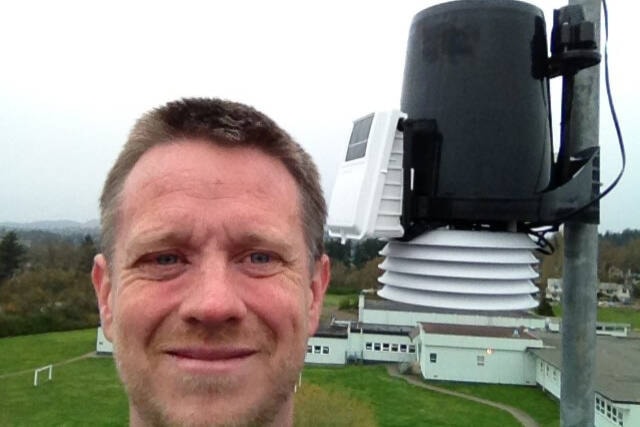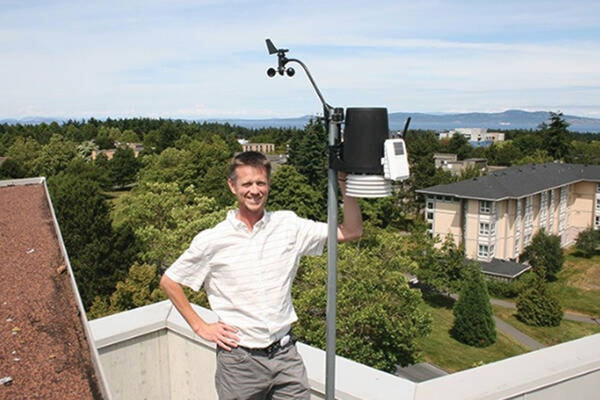Perched on schools across Vancouver Island, 164 weather stations sit waiting to transfer data.
Of them, only 40 are working. The rest are offline or in need of repairs.
The network is not operating at anything close to its best, according to Ed Wiebe, one of two University of Victoria staffers who created the program more than 20 years ago.
Wiebe and Andrew Weaver first put up a weather station at their UVic office in 2002.
B��Ԫ������ַ�I think that pretty much inspired this notion that we could use this local weather information as a public outreach and education tool to educate people about climate,B��Ԫ������ַ� Wiebe said.
B��Ԫ������ַ�It hasnB��Ԫ������ַ�t worked in the sense that people didnB��Ԫ������ַ�t see that as a way to learn about climate change, but it did work in getting people excited thinking about weather and how each little region has different weather day-to-day.B��Ԫ������ַ�
READ ALSO:
Back then, Wiebe was a research associate in UVicB��Ԫ������ַ�s renowned Climate Modelling Group Lab, led by Weaver who found funding through the Greater Victoria School District.
Part of the projectB��Ԫ������ַ�s mandate was to educate and engage students with science, when resources are available. Each station comes with a display monitor that teachers and students use to follow along.
The stations record and report the temperature, humidity, wind speed and direction, air pressure, rainfall, sunshine (solar power), amount of sun energy coming in, UV index and rain rate. ItB��Ԫ������ַ�s all collected in a server at UVic and made available (with a four minute delay) on the website and app.
Some schools charted the data each day on the wall in the hallway, and some have students announce the daily weather report during morning announcements.
With word of mouth the project grew, and funding allowed for installation farther afield including Campbell River and beyond to more remote areas such as Gold River, Tofino, Ucluelet and Nitnat Lake.
Weaver became an MLA and Wiebe was hired at the School of Ocean Sciences who offered him some time to maintain the stations.
B��Ԫ������ַ�But the money has basically run out,B��Ԫ������ַ� Wiebe said. Running the network solo since 2013, and now also teaching first year labs, his time is also running low.
B��Ԫ������ַ�I just canB��Ԫ������ַ�t get out much,B��Ԫ������ַ� he said. B��Ԫ������ַ�It kind of just has petered out. ItB��Ԫ������ַ�s kind of a disappointing B��Ԫ������ַ� I donB��Ԫ������ַ�t want to call it an ending.B��Ԫ������ַ�
With more than three-quarters of the school stations offline, and a growing online following, the pair is pursuing a plan for redemption.
B��Ԫ������ַ�In the past days and months Andrew and I have heard from many people who have found and enjoyed the free community resource. WeB��Ԫ������ַ�ve heard from many people in the community who have offers of help or cash. We havenB��Ԫ������ַ�t been able to accept those offers. Volunteers are complicated due to the locations of most of the weather stations in schools,B��Ԫ������ַ� Weibe said.
RELATED:
With Weaver back at UVic, the pair plans to develop a strategic plan to secure new funds and hire staff to visit weather station sites and to pay for equipment to make repairs.
B��Ԫ������ַ�WeB��Ԫ������ַ�re writing up some proposals and hopefully we can get some kind of a source,B��Ԫ������ַ� Weibe said. B��Ԫ������ַ�ItB��Ԫ������ַ�s always been a passion project.B��Ԫ������ַ�
He also hopes the many institutional users of the data B��Ԫ������ַ� such has municipalities, engineering firms and researchers B��Ԫ������ַ� might consider funding.
The pair hopes to get the school weather network back online quickly.
B��Ԫ������ַ�After this we will look at updates to the website and a new app for phones so that people can once again find out whatB��Ԫ������ַ�s going on in their neighbourhoods,B��Ԫ������ַ� Weibe said. B��Ԫ������ַ�When we get a new plan in place, weB��Ԫ������ַ�ll be sure to let everyone know.B��Ԫ������ַ�
Find the school-based weather network online at .




